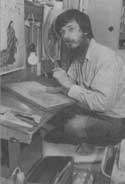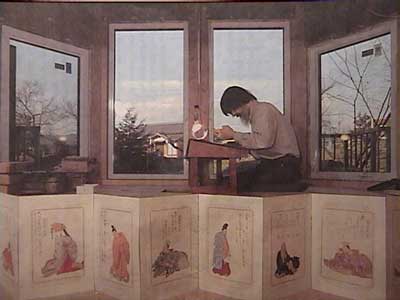'Human Drama' : Part One (of five)
'Human Drama' - A Canadian woodblock printmaker's 10 year journey ... Part One
(Aired on TV Tokyo in February 1999) ... a one hour made-for-TV documentary program. Although I feel that the producer focussed rather too much on the melodramatic aspects of our family life during that ten year period, the program does indeed give a pretty good overview of what the project was like ...
Part 1 : 6 1/2 minutes
Part 2 : 12 minutes
Part 3 : 7 minutes
Part 4 : 9 minutes
Part 5 : 9 1/2 minutes
A .pdf file with a rough guide to what is being said during the program is here.
TV Listings
The 'Woodblock Shimbun' has a full selection of TV programs on file. Videos available include some of David's news appearances, complete feature programs, and some short documentaries on his work. The files are in QuickTime format, and can be easily viewed with your browser.
Program listings are on the Index page ... ![]()
Woodblock Prints in a Different Light
"Let me ask you a silly question: Have you ever seen a woodblock print before?" ukiyo-e printmaker David Bull asked me. "Of course you have. But do you know how to look at a woodblock print?" He held a postcard-sized print under the fluorescent light in his cluttered kitchen. "Is that a woodblock print, or is it printed by a machine, or is it a photograph? (1999)
Full Story. ![]()
Carving a Career From an Ancient Japanese Craft
David Bull, a 41-year-old Canadian university
dropout born in England who used to program computers and play the
flute on the street, anticipates one day finding himself revered as a
master practicioner of an ancient Japanese craft. But it took him 35
years to hit upon that uncommon ambition. (1993)
Full Story. ![]()
Woodblock craftsman combines old, new
Day after day, David Bull sits in his workroom almost all day long using his energy to make hanga or woodblock prints. His workroom, housed in his four-story house standing on the side of a riverbank in Ome, Tokyo, has yet to be completed because he is building the room himself by taking time from his busy production schedule. (2004)
Full Story. ![]()



